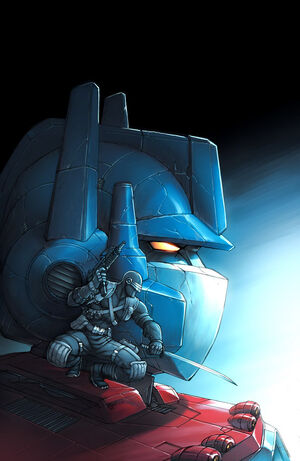
And the truck's how big...?
Scale in Transformers is, not to put too fine a point on it, screwed.
Virtually no era, franchise, fiction, toyline or other incarnation of Transformers has presented scale in a logical or believable fashion. (Save perhaps, the 1:24 toys for Alternators and Kiss Players, but they have their own problems.) Most fans agree that one must either ignore it or accept it, lest they be tempted to explain these problems and in the process fanwank themselves into oblivion.
However, the scale problems of Transformers still merit description.
Scale within toylines
Toys out of scale with others in the same line
The early Generation 1 toyline, especially the pre-movie lines, were repackaged and redecoed toys from several different Japanese toylines. The crucial point is that the toylines were initially unrelated. The characters should be in scale to each other as they all have real-world altmodes that (should) pass for real vehicles. However, since Diaclone toys were not part of the same line as Microman toys, scale issues arose. Diaclone figures such as Optimus Prime, Prowl and Hound are more-or-less in correct scale to each other, but many of the Mini Vehicles from the New Microman line are clearly far too small by comparison. Even aside from their deformed penny-racer proportions, a Volkswagen Microman toy is disproportionately tiny when compared to a Porsche Diaclone toy. The disparity becomes even more obvious with minibots such as Warpath (a tank) and Seaspray (a hovercraft) who should be many times their actual size.
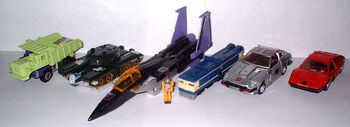
That little guy — who comes from the same toyline as all those vehicles — is supposed to be a normal-sized human. Yeeeah.
Another glaring scale problem comes in the form of the Seekers, who turn into F-15 Eagles which, in real life, are 63.8′ (19.4m) long. Correctly scaled, this would make their robot modes colossal compared to most Autobots. Similarly, the Constructicons, despite also coming from the Diaclone line, are too small. Far worse is the other Diaclone combiner team, the Trainbots, who have train engine altmodes, yet their toys are among the smallest of the Diaclone releases.
Toys out of scale within teams
Even toys specifically designed to interact with each other suffer from this problem. The Combaticons are wildly out of scale to each other — Blast Off's space shuttle mode should dwarf Swindle, with the others somewhere in between. Instead, they're about the same size. Among the Constructicons, Long Haul is designed to look like a gigantic "earth-mover" mining truck. He should be able to carry all his teammates in his bed, with some crowding. Similarly, Silverbolt (a Concorde jet) is dramatically undersized compared to his fighter-jet Aerialbot teammates. These scale problems are necessary to avoid misproportioned gestalt forms.
Same altmode, different sizes
Other scale problems come from characters who transform into the same (or similar) altmodes but whose toys are different sizes. For example Air Raid transforms into an F-15 Eagle, but his toy is half the size of Starscream's. The same can be said for the Lamborghini Countach Breakdown, who should be the same size as Sunstreaker, not significantly smaller. These discrepancies are also seen in the other Scramble City combiners with Earth altmodes, whose toys are all smaller than similar earlier toys.
Toys out of scale with themselves
Triple-Changers create a whole new set of problems. Octane transforms from a 60′ (20m) tanker truck into a 200′ (65m) jumbo jet. Broadside transforms from an Earth jet into an entire aircraft carrier.
Even a two-mode toy can have this problem. Twentieth Anniversary Optimus Prime has wheels which are pretty tiny for a Freightliner truck, while his rear hitch section is too thick. These out-of-proportion vehicle parts were necessary to give his robot mode show-accurate proportions.
Toys with roleplay altmodes
The characters with roleplay altmodes such as Generation 1 Megatron, Soundwave, Perceptor, or Armada Laserbeak are scaled to be human-scale (well, kid-scale). Since the size changing seen in the fiction is not possible for real toys (at least, that's what Takara wants us to think), this human-scaling makes in some cases for inordinately large robot modes. E.g., Blaster's toy, in robot mode, is taller than most other Transformers.
The opposite problem is seen with Masterpiece Megatron, whose robot mode is in scale with Masterpiece Optimus Prime. The result is that, while he may transform into a very accurately-proportioned handgun, it's much larger than the real thing.
Fanciful altmodes
Most post-movie Generation 1 characters (for that matter, most post-Generation 1 lines) are difficult to accurately scale, as they generally transform into futuristic or Cybertonian vehicles whose size we don't really know. (Or, indeed, they don't transform into vehicles at all.) The scale of characters such as Hot Rod or Leobreaker is fairly arbitrary and can only be estimated by their relative size to other characters in the fiction (although most fiction is highly inconsistent in this regard, see below). Nevertheless, if one assumes that most vehicle altmodes are intended for human passengers, comparing toys such as Chromedome and Lightspeed suggests the combiner scale problem continues.
Big toys
It goes without saying that the citybot and planetbot toys (Such as Fortress Maximus and Unicron) are not remotely to scale with normal Transformer toys. While they are indeed large toys, they're only two to five times bigger than typical Transformer toys, and thus transform into "cities" and "planets" about the (relative) size of a bungalow. The scale problems extend to the details. Some of the citybot toys have visible windows, which are too large for a city, suggesting instead a medium-sized building.
However, it's hard to begrudge Hasbro not offering us a Primus toy the size of an asteroid. Where would we keep it?
An exception
There has only been one notable exception to all of this scale weirdness in the toys: the Alternators toyline, where every toy is a 1:24-scale representation of a real car, and thus they are in perfect scale with each other. Unfortunately, for practical reasons this limits the choice of altmodes. A Blast Off (space shuttle) Alternator toy would be 5.1′ (1.6m) long, while a Broadside (aircraft carrier) Alternator toy would be over 40′ (12m).
Scale within fictions

Frighteningly toy-accurate.
Scale issues abound within the fiction, especially the Generation 1 cartoon. A lot can be attributed to animation errors, but some "errors" were deliberate choices, for a variety of reasons.
Animated scale ≈ toy scale
Very broadly speaking, the Generation 1 cartoon depicts characters to the same relative scale as the toys (including problems discussed above) when depicting the characters in robot modes. Prime, Megatron and Soundwave are generally animated at the same height, Seekers and Autobot cars slightly shorter (though not as much as the toys are), and Minibots smaller yet. However, this was far from consistent.
Comic scale ≠ toy scale
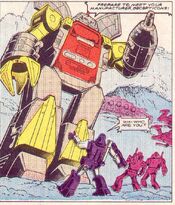
No! Don't wash him in hot water! He'll . . .
The Generation 1 Marvel comic is notorious for changing the relative sizes of various characters. A single Transformer's size is rarely consistent between artists. For example, Rumble and Frenzy vary in height relative to Soundwave. A panel in the Time Wars shows Goldbug, Ironhide, Scattershot, and Swoop all the same height. Omega Supreme, titanic in his original appearance, shrunk steadily in subsequent issues until he was not much taller than the average.

. . . too late.
Variation for characterization
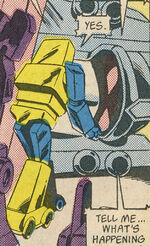
With 20th Anniversary Prime and Smallest Transformers Bumblebee, you can actually recreate this scene.
Some scale problems are for the sake of characterization. For example, Optimus Prime is routinely shown as thoroughly gargantuan, several stories in height, and capable of cradling humans in his palm. If he's the size of a real truck, Prime in robot mode should be 25′-30′ (8m-10m) tall, at best. He's drawn large because he's a leader character.
Conversely, Bumblebee is sometimes shown only a few feet taller than an average human, while in reality he would be 10′-15′ (3m-5m) tall (the Marvel comic actually states he's 15' tall[citation needed]). He's drawn small because he's a human-friendly character, and a junior member of the Autobots.
Those pesky Seekers remain a major scale problem; with plane altmodes they would be among the largest everyday Transformers and would tower over their Autobot adversaries, whereas the animation instead depicts characters such as Thundercracker and Wheeljack as about the same height. Though jets are much larger than cars, they're drawn the same height so the battles appear fair. (And also to make it easier to animate; blocking a shot where characters differ radically in height is difficult.)
In a related vein, sometimes Transformers are able to enter human buildings, fitting through their doors and able to run up their staircases without crashing through. A cast that couldn't enter buildings would be grossly inconvenient for telling some stories, so the animators fudge things.
Transport characters
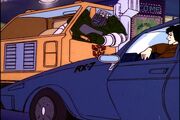
Definitely not toy-accurate.
Transformers that act as transport for other Transformers will often dramatically change size relative to their compatriots between one shot and the next. These changes in scale are usually attributed to implicit size changing by that portion of the fanbase who like to find explanations for things. The other explanation is that the animators hoped the audience wouldn't notice. (See the size changing article for more discussion of this topic.)
Combiner characters
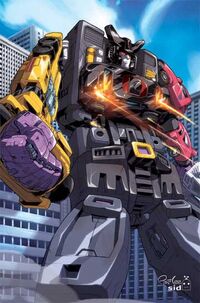
Since when is a sedan nine stories tall?
Combiner characters are often depicted as far larger than the sum of their parts. Characters such as Devastator and Menasor are frequently shown as Godzilla-sized. Given that their limbs are mere cars and construction vehicles, this is patently absurd. (Superion, by contrast, would be building-sized, given that his torso is a 100-seat jetliner.)
Combiners are also often out-of-scale with other Transformers; a combiner with cars for legs and another car for its torso should be only twice as tall as a one-car Transformer, but they are routinely drawn as five to dozens of times taller than their comrades.
Pretender characters
The Pretenders had interesting scale issues. In the original comic the Pretenders appeared fairly literally as their toy counterparts; Transformer-sized robots inside Transformer-sized humanoid shells. The result was that the Autobot Pretenders (in their shells) were giant-sized humans. This successfully disguised them (for about five seconds, literally) from the Decepticons, and also hid their mechanical nature from aliens. However, it was utterly useless at fooling humans. Further, in one story, the Pretender Cloudburst exited his shell, transformed into jet mode, and then his shell (and Landmine) boarded him as a passenger. The fact that his outer shell was now smaller than the inner robot was quietly ignored; one assumes the sort of size-changing mentioned under Transport characters, above, was involved.
In the U.S. toy commercials, Grimlock, Bumblebee, and Jazz in their new Pretender forms were small enough to fit in Powermaster Optimus Prime's hand. So, at least in that micro-continuity, they were human-sized.
(The Japanese-only series Super-God Masterforce featured Pretenders who did not have outer shells but rather an ill-defined holistic transformation which explicitly involved size changing. A vaguely similar explanation appeared in Dreamwave's More Than Meets The Eye encyclopedia.)
Small Transformers
The assorted toys produced over the decades to hit the lowest price point usually include "mini" or "micro" in their name, and usually are depicted as smaller than other Transformers in the fiction as well.
Micromasters
The Micromasters are roughly human-sized in robot mode, and thus virtually all of them turn into Earth vehicles that are patently incapable of seating human passengers inside them. (The Marvel comic featured some of them implicitly size-changing to vehicles that could carry human passengers, but this was rare.)
The Dreamwave miniseries Micromasters had an explanation, suggesting the Micromasters were Transformers scaled to fit a smaller race of humans. This is met with skepticism from fans, in part because it doesn't explain the scale problems within the line. All Micromasters are about the same height in robot-mode, but they transform into small cars, large trucks, planes, tanks, and other vehicles that should be vastly different sizes. The alleged "smaller race of humans" must vary in size quite a bit, and only the really teeny ones get to fly the planes . . .
To be fair, there is little indication in the fiction that the Micromasters were supposed to have consistent scale. They were explictly downsized Transformers, and the scale problems inherent to that resizing were tacitly part of the fiction. Their passenger compartments can thus be regarded as vestigial.
Mini-Cons
The Mini-Cons of the Unicron Trilogy are another race of small robots who stand approximately the same height as humans and, like the Micromasters before them, are clearly modeled to carry passengers. Really teeny passengers. (Notable exceptions are Grindor (in his original body), Sureshock, and High Wire, who become small one-man vehicles.) In this continuity, there's no sign of mini-passengers. The prevailing theory is that Mini-Cons scan normal vehicles and then resize them to fit, retaining now-useless passenger compartments. In the Cybertron cartoon, the Recon Mini-Con Team have slightly-larger-than-human robot modes, but their alternate modes are large enough for a single human passenger, implying either a little size-changing, or that their cockpits are kinda cramped.
Big Transformers
On the other end of the scale, the problems posed by really big Transformers lie in how they interact with normal-sized ones.
Citybots

If you were ever this big in the cartoon, then we might call you a city.
The characters Metroplex, Trypticon, Fortress Maximus and Scorponok have "city" altmodes (with Fort Max being supposedly the biggest of the four). However, a size at which they could house enough humans, let alone Transformers, to be reasonably defined as a "city", would suggest a robot-mode that'd make Godzilla look like a gecko. Suffice to say, they're rarely drawn that big. It doesn't help that these citybots have "small" robots forming vital components. Fortress Maximus and Scorponok both have "human-sized" beings forming their heads. (Fort Max has a middleman in there, but still.) Full-Tilt, Six Gun, and Slammer must logically be building-sized in robot-mode to be in-scale with Trypticon and Metroplex, but, again, are not drawn as such. Aside from the sole depiction of Metroplex in the Marvel UK story Space Pirates, no fiction, not even the very large depiction in the Headmasters cartoon, even begins to approximate the logical size of a true "citybot". In reality, the grossly-undersized depictions of Unicron (see below) would be closer to the size of a transformed city. This is ironic, as in Season 3 of the Generation 1 cartoon Unicron requires the eyes of a citybot to replace his own. (Though, "realistically", his eyes should be the size of Texas.) Rare examples of a realistic citybot scale include some Japanese promotional art (e.g., at right).
The cartoon episode "Thief in the Night" makes a stab at explaining this via an establishing shot that shows Metroplex to be a small sub-section of the "actual" Autobot City, although this was not repeated. Overall, it seems that in Transformer terms, "city" is better read as "building".
Although little fiction to date has featured the Headmaster leaders as cities, in the Japanese cartoons they have been employed in their tertiary modes as starships capable of housing many normal-sized Transformers. Conversely, the Marvel Generation 1 comic depicted Fortress Maximus and Scorponok as merely "large-standard" characters, equal in height to Powermaster Optimus Prime and (in some UK issues) Rodimus Prime. (To be fair, Powermaster Prime was often drawn undersized in the comics).
Planets and planetbots
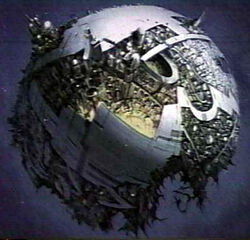
If we're generous and assume Cybertron is only the size of Earth's moon, then the larger visible buildings are roughly the size of Massachusetts stood on end, and you could wedge France into that gash. (Which would probably improve both Cybertron and France.)
Scale when it comes to planets is so fraught it's painful. The problems of describing citybots as "cities" is a thousand times worse if Unicron is supposed to have a planet alternate mode, and Cybertron is in turn supposed to be of similar size. Though different stories have compared Cybertron/Primus and Unicron to drastically different real planets, the fact remains that they are planets, and yet are shown in such insane scale to characters as to suggest they are the size of a very small moon (or space station).
To start with, Cybertron was shown throughout Generation 1 with buildings visible from space. Although this was intended to show that the planet was technological in nature, it makes little sense, as the structures would have to be the size of small nations to be visible. If the buildings were in fact supposed to be skyscrapers (or even 2000 A.D. style arcologies) sized for 30' (10m) robots, Cybertron would still be less than 100 miles (150km) across. By comparison, the rather Coruscant-like shots of Cybertron in Beast Machines may be less distinctive or "Cybertronian", but are far more believable.

Unicron is a more extreme problem. Assuming no size changing occurs during his transformation, in robot mode he would be so massive that any shot featuring a recognizable part of his body, let alone the whole thing, would be on a scale such that no normal Transformer would even be visible. Scenes in the Movie in which he directly interacts with normal Cybertronians are blatantly absurd (though totally phat-looking). Shots such as the Dinobots fleeing his grasping hand, a starship penetrating his eye, or especially him picking up Galvatron between his fingers before swallowing him, break any concept of "planetary" scale. If Unicron is the size of a planet, his hands would be the size of continents. This would make Galvatron (in the image to the right) the size of Great Britain.
There is no explanation for any of this. Just go with it.
The depiction of Unicron's scale in Armada was (debatably) a slight improvement, in that physical interaction with normal beings was not attempted. He preferred instead to communicate with normal Transformers by possessing one of them. Nevertheless, shots featuring Thrust and Megatron standing on his neck are still farcically out of scale.
An exception: The 2007 Transformers movie
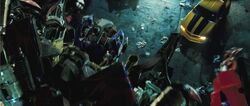
Scale is absolutely not an issue in the movie. Riiight.
The creators of the live-action movie took great pains to avoid out-of-scale issues. (Well, greater than previous franchises.) This is sometimes reflected in the choice of vehicle or the design of their robot mode. E.g., Optimus Prime is an extended-hood cab in order to have more mass to make a taller robot mode with. Starscream's robot mode is nearly as wide as it is tall, with shorter, digitigrade legs, so the massive jet-former won't end up twice as tall as Optimus. In the case of Blackout, his huge alternate mode simply results in a hulking, towering robot mode.
There are still minor scale issues to be found, though. For example, Optimus Prime can hold both Sam and Mikaela in one hand. Comparing this shot with when he picks up Archibald Witwicky's glasses a few minutes later, it seems the glasses have lenses a foot (30cm) in diameter. This is a visual cheat so the glasses are visible to the audience. There's also debate about whether Frenzy's head could compact itself into a slim mobile phone. The movie-franchise toys, meanwhile, are only intermittently consistent (particularly since some of the secondary ones are redecos of toys from previous lines), though many of the wheeled vehicles are close to 1:35 scale.
Scale problems and size-changing
Some fans interpret the many otherwise-unexplained scale issues above to all be the result of size changing, but this is debatable. If virtually all characters use mass-shifting (or whatever) to gain or drop a few feet of height for no logical reason, the technology would be pointlessly mundane. There's also no known reason for (e.g.) the Seekers to choose to get shorter when going into battle. A to-scale Starscream in robot mode could kick Bumblebee around like a soccer ball. There's simply no positive evidence that size-changing is so widespread.
Official Scale Guides
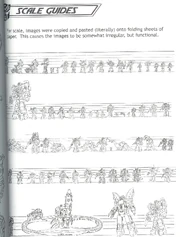
Official Scale Guides
Animators and comic book artists were given official scale guides that showed relative and in some cases absolute heights. Some of these were published in the character model guide Transformers: The Ark. Though they were not consistently followed, they give some insight into the official heights of characters in the G1 Marvel series and the G1 cartoon. Even in this format, there are scale problems. Devastator in the season one scale guide was approximately 2.5 times the height of Optimus Prime, but by season two he was somewhat less than 2 times Prime's height.
Show scale vs. toy scale
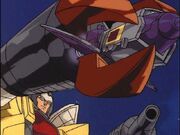
I know he's meant to be big, but holy crap, dude!
Some characters have great discrepancies between their cartoon scale and their toy scale. "Giant" characters such as Omega Supreme are, even aside from any size changing for transport purposes, clearly not in the same scale in toy form as they are depicted on screen. Cassette characters such as Rumble's toys are roughly the same height as most Minibots, while in the show they are usually portrayed as human-sized.
Rodimus Prime and Ultra Magnus are usually shown to be of a fairly similar height (although Magnus is much bulkier), whereas there is a considerable difference between the size of their toys. By the same token, Rodimus is always depicted as being an equal stature to his opposing leader Galvatron, whereas the toy Galvatron is instead the same size as Magnus. Optimus Prime is also usually shown as only a head or so shorter than Magnus (if that), which gets very strange when you realise that a redco of Prime's toy forms but a small part of Magnus' robot mode.
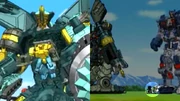
I lost thirty tons, thanks to the Jump-Cut! Thank you, Jump-Cut!
Cybertron Metroplex and the other citizens of Gigantion are depicted as gargantuan in animation, whereas the toys are merely among the normal boxed size-classes. (Although, the Japanese Galaxy Force release, dubbed "Megalo Convoy", included an exclusive redeco of the Legends of Cybertron Optimus Prime to indicate the "correct" scale.) Within the animation, though, this causes problems with their Mini-Con partners, who are depicted as human-sized in robot mode by themselves, but when directly interacting with their larger partners, have their relative size in relation to the toy . . . meaning some temporarily gigantic Mini-Cons!
Beast Era scale
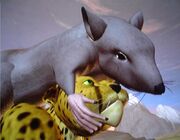
I'm tellin' ya, all da rats in Brooklyn are dis big!
In the Beast Era, scale is not such a large issue, although it does crop up in less obvious ways.
Real world scale
Although the Beast Warriors are consistent day-to-day in their relative size to each other, their scale in relation to their real-world animal equivalents is more complex. While the bug characters such as Waspinator and Inferno are obviously scaled-up, most of the characters are subtly not quite the right size.
Cheetor and Tigatron are the only characters shown standing next to real members of their species, and they are both the same size as the animals in question. Beast Wars, Part 1 Law of the Jungle This makes them (and Cheetor in particular, since he's around more) the measuring sticks for the other characters. Therefore, Rattrap is a monstrously huge rat, the size of a large dog (indeed, the writers stated[citation needed] that Season 1 Rattrap was 5' (1.5m) tall). Dinobot is considerably larger than a real velociraptor, closer in size to a Utahraptor. Rhinox is a rather small rhinoceros, and Optimus Primal is a roughly normal gorilla. However, Megatron is a positively dwarfish specimen of t-rex, closer to a Nanotyrannus.
In their interactions with (adult) protohumans, the Transformer characters seem between twice and three times their height. Considering our ancestors really were smaller than modern humans, this issue is not extremely wrong, but it deserves noting.
Scale relative to Generation 1

Beast Megatron's size vs. Optimus Prime in America... and Japan. I guess the Blasty Zone adds on a few tons to Beast Era characters
Between the Great War and the Beast Era, the majority of the Cybertronian race considerably downgraded in size, apparently in the Maximal Upgrade Program. (A necessary premise of the show, as the Beast Warriors are supposed to transform into roughly-normal-sized animals, not vehicles.) When entering the Ark, the Beast Warriors are quite small compared to the dormant Generation 1 characters, especially Optimus Prime. One can easily imagine them sitting inside the passenger compartments of the Generation 1 characters. When interacting with the Autobot technology of the Ark and the Autobot shuttle, the Maximals are visibly dealing with equipment grossly oversized for them (standing on the chairs to reach the controls, turning knobs the size of their heads), but overall manage okay. This does not always apply, as the Ark also seems to feature some human-sized control panels, such as the computer in Master Blaster. Without any height booster, Blackarachnia can interface well with the controls. A similar situation crops up in Season 1 of the original cartoon, such as when Chip Chase can easily type on and manipulate Teletraan-1.
On the other hand, Robot Masters depicted Generation 1 and Beast Wars characters like Optimus Prime and Optimus Primal as being exactly the same size. Lovely. It's possible that passage through the Blasty Zone may somehow account for this discrepancy.
Toy scale vs. cartoon scale

Airrazor picks the Ultra-class figure.
The Season 1 cast of Beast Wars were not designed with the same relative sizes as the toyline. The most noticeable problem is Optimus Primal, who has an Ultra toy (almost twice the size of the next-largest Maximal toys), while in the show he's shorter than both Dinobot and Rhinox. Further, Cheetor and Tigatron's toys use the same mold, but Tigatron is a head taller in the show (both because tigers are larger than cheetahs, and because Cheetor is "a kid").
From Season 2 onwards, new characters, and new bodies for old characters, became more consistent in size (and appearance) with their toys.
The Beast Machines' toyline was far worse in size discrepancies with the cartoon. Of the Maximals featured in the show, the tallest character, Silverbolt, is the shortest toy, while the diminutive Nightscream is a massive Ultra-class toy. And, sadly, the most show-accurate toy, Air Attack Optimus Primal, is a ginormous Supreme figure, towering over the other toys. (Weirdly, the King Kong-like size of this toy became canon in one specific micro-continuity.)
